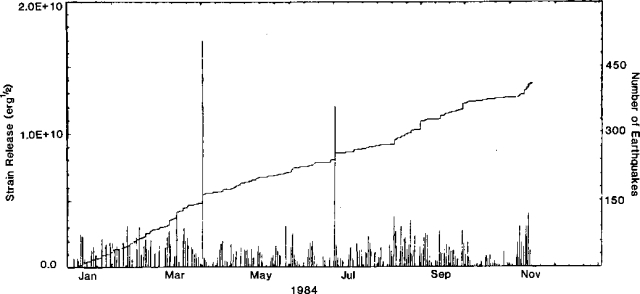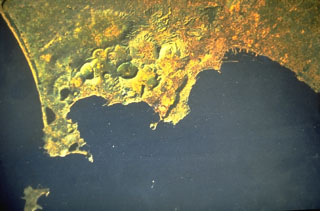Report on Campi Flegrei (Italy) — June 1984
Scientific Event Alert Network Bulletin, vol. 9, no. 6 (June 1984)
Managing Editor: Lindsay McClelland.
Campi Flegrei (Italy) Seismicity and uplift continue; socio-economic impact discussed; increased submarine fumarolic activity
Please cite this report as:
Global Volcanism Program, 1984. Report on Campi Flegrei (Italy) (McClelland, L., ed.). Scientific Event Alert Network Bulletin, 9:6. Smithsonian Institution. https://doi.org/10.5479/si.GVP.SEAN198406-211010
Campi Flegrei
Italy
40.827°N, 14.139°E; summit elev. 458 m
All times are local (unless otherwise noted)
"Seismic activity remained at a low level for most of May and June. The mean velocity of uplift, measured by the Pozzuoli tide gauge, was of the order of 3 mm/day in May.
"We were puzzled by the low level of seismicity and the relatively high rate of ground uplift. Our previous experience indicated that uplift velocities greater than 2-3 mm/day in Pozzuoli are often associated with increased seismic activity. This had not happened during April and May. We were suspicious that a change might have occurred to the system. Finally, there was a small swarm of 80 events in 2 hours on 28 May. The maximum magnitude was 2.0. The location of the swarm was in an area ~1 km W of downtown Pozzuoli, in the same area as the swarms of 13 October 1983 and 1 April 1984. The significant difference is that this time we were able to identify three low-frequency events that occurred at the beginning of the swarms. They had unclear onsets and a typical frequency of ~1 Hz. Two were sufficiently well-recorded on many stations of the network to have a good location, in the same area as the swarm. These events have remained isolated so far, but we have alerted personnel to look carefully for other occurrences. We cannot exclude the possibility that other occurrences may have passed unnoticed. Unfortunately, the bad season, with frequent sea storms, and high human background noise may have completely hidden the low-level seismic activity.
"Four magnitude 3+ earthquakes occurred 1-2 June near Solfatara Crater on the E edge of the active seismic area, where we again observed that the most energetic events occur. Two events of magnitude 3.3 and 2.6 occurred 17 June on the E side of the caldera near the Nisida Peninsula, and a magnitude 3.6 event on 27 June was located in the center of the Gulf of Pozzuoli. They are the most energetic events that have occurred in these areas. On 1 July, a M 3.6 event started a swarm of more than 100 events near Solfatara Crater. Another M 3.5 event occurred during this swarm.
"Uplift measured by the Pozzuoli tide gauge was ~1 mm/day 1-24 June. A new tide gauge was installed on the E border of the caldera (in Nisida) to monitor the differential movement of the caldera. It gave a value of 0.2 mm/day 1-24 June. A levelling survey was completed in June. Preliminary data indicate a maximum uplift of 17 cm with respect to March 1984. The center of maximum uplift remained in the same area as in previous levellings totaling 160 cm since January 1984.
"At the end of May, divers reported a visible increase in submarine fumarolic activity in the Gulf of Pozzuoli, in front of Monte Nuovo Crater (site of the last eruption at Campi Flegrei, in 1538). We still do not know how to monitor this activity. A few pictures have been taken at different times, but we do not know if the increased activity occurs episodically.
"Radon measurements have been routinely performed since April 1983 in two water wells. They gave evidence of a strong peak (of probable seasonal origin) during the winter (figure 7). Fluctuations of smaller period are superimposed on the trend. Fumarole temperatures in Solfatara Crater remained at 158° and 110°C, with variations of only a few degrees.
 |
Figure 7. Daily number of earthquakes at Campi Flegrei (vertical lines) and cumulative strain release (curve), January-November 1984. Courtesy of OV. |
"Discussions have been carried out on the character of recognizable short-term precursors, if any, of a possible volcanic event in the area. We were strongly relying on a significant increase in seismic activity days before an eruption. We based this assumption on historic chronicles of the eruption of Monte Nuovo. The occurrence of three swarms without any evident volcanic activity has reduced our confidence in recognizing a swarm as a possible precursor of volcanic activity. The maximum duration of a swarm has been 6 hours. We are now relying on the total energy release during a swarm and on the character of the seismic activity. We have never observed harmonic tremor or a significant number of low-frequency events. The deformation rate is another possible precursor, but we could recognize it as a precursor if a significant uplift occurred in a matter of days before a volcanic event. The magnitude of the uplift should be at least the same as the daily sea tide (tens of cm). We are planning the installation of more tide gauges, to be able to detect more localized uplift if it occurs. Geochemical monitoring is presently carried out mainly in Solfatara Crater; plans have been made to extend this monitoring to other areas.
"The beginning of the summer season is increasing the demographic pressure on the area. The evacuation order in the central part of the caldera is not strictly enforced. The high density of population of the area (250,000 people live within the caldera) is posing a tremendous problem with respect to the measures that should be taken to reduce the hazard.
"The length of the present crisis (two years since the beginning of uplift) has produced a social impact and economic loss comparable to that of an actual eruption. The researchers, devoted to the difficult task of monitoring and understanding the development of the phenomenon, suffer from the accumulated stress of being responsible for the lives of thousands of people."
Geological Summary. Campi Flegrei is a 13-km-wide caldera that encompasses part of Naples and extends to the south beneath the Gulf of Pozzuoli. Episodes of significant uplift and subsidence within the dominantly trachytic caldera have occurred since Roman times. The earliest known eruptive products are dated 47,000 years BP. The caldera formed following two large explosive eruptions, the massive Campanian ignimbrite about 36,000 BP, and the over 40 km3 Neapolitan Yellow Tuff (NYT) about 15,000 BP. Following eruption of the NYT a large number of eruptions originated from widely scattered subaerial and submarine vents. Most activity occurred during three intervals: 15,000-9,500, 8,600-8,200, and 4,800-3,800 BP. The latest eruption were in 1158 CE at Solfatara and activity in 1538 CE that formed the Monte Nuovo cinder cone.
Information Contacts: G. Luongo and R. Scandone, OV; F. Barberi, Univ. di Pisa.

